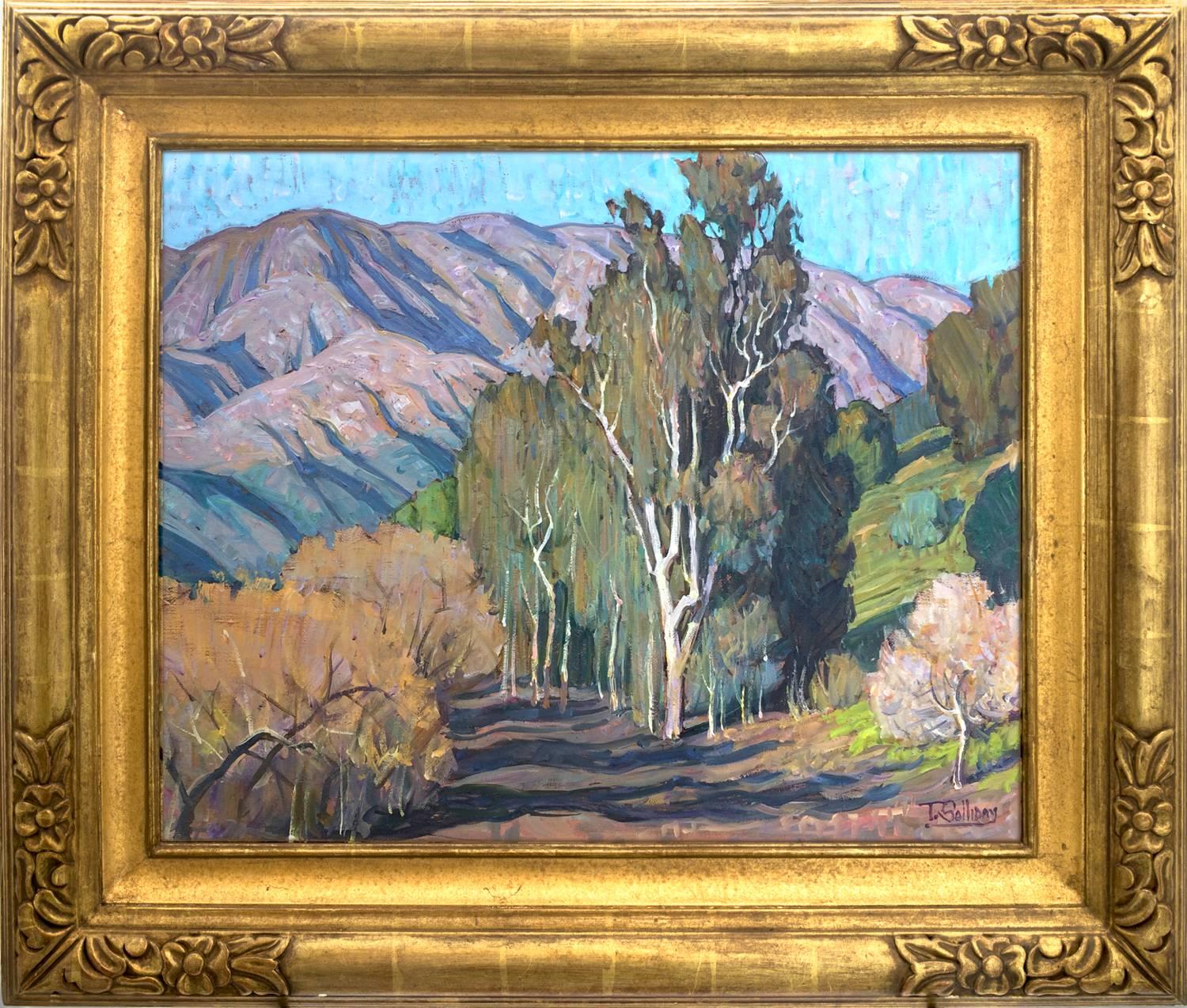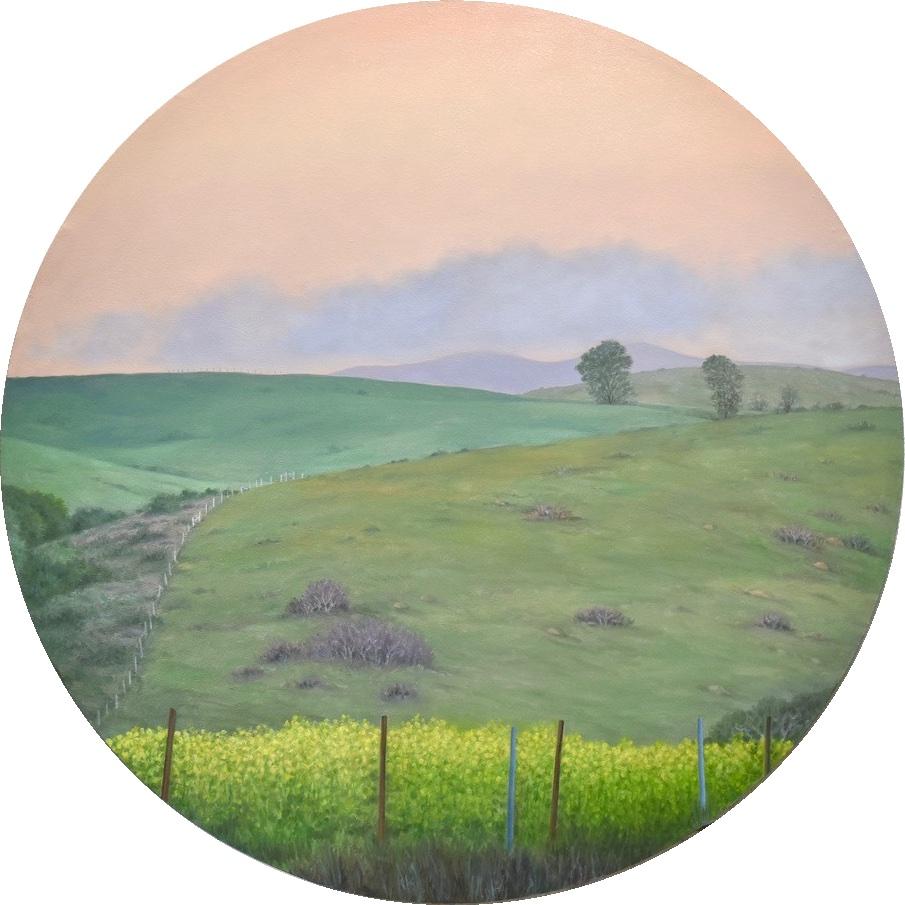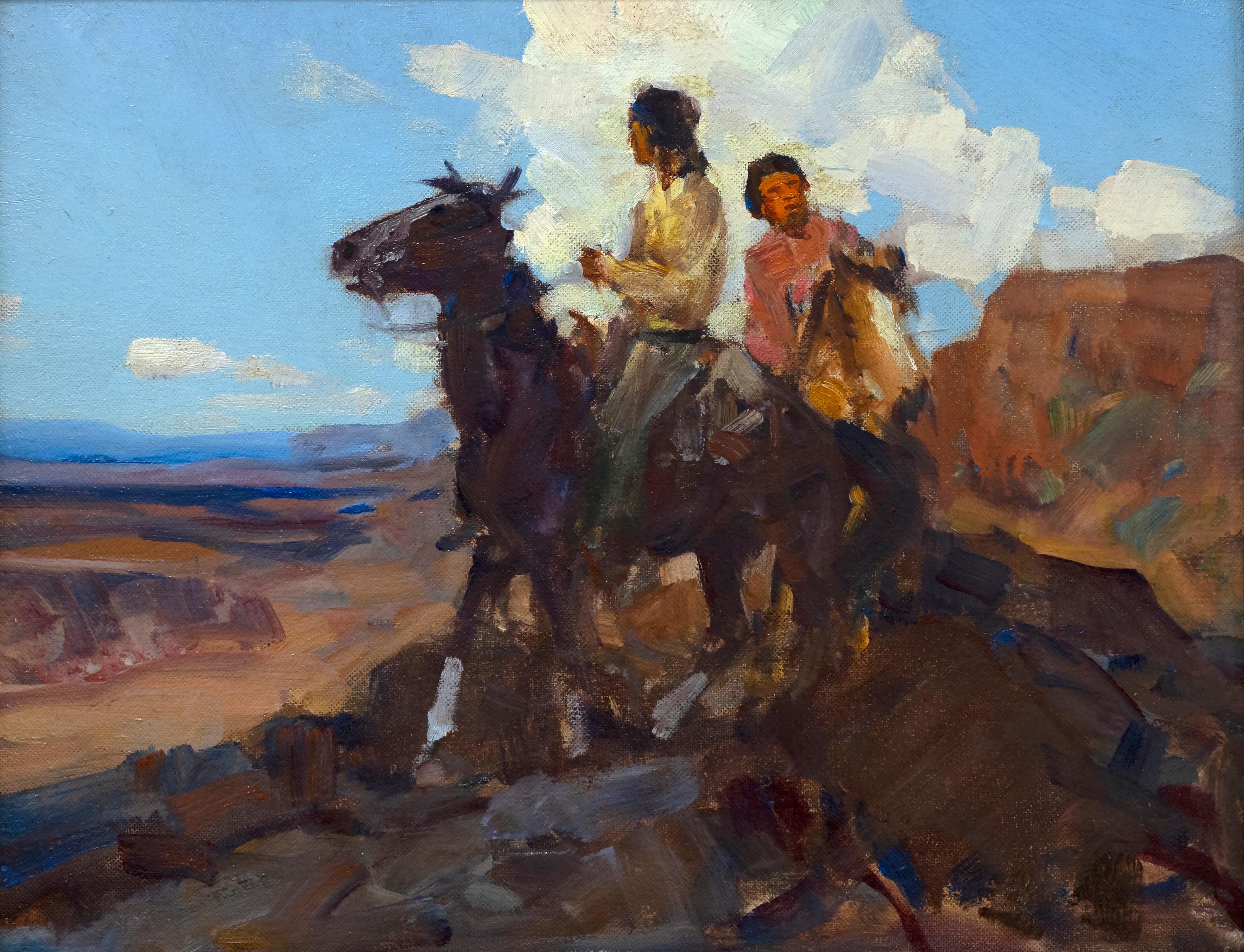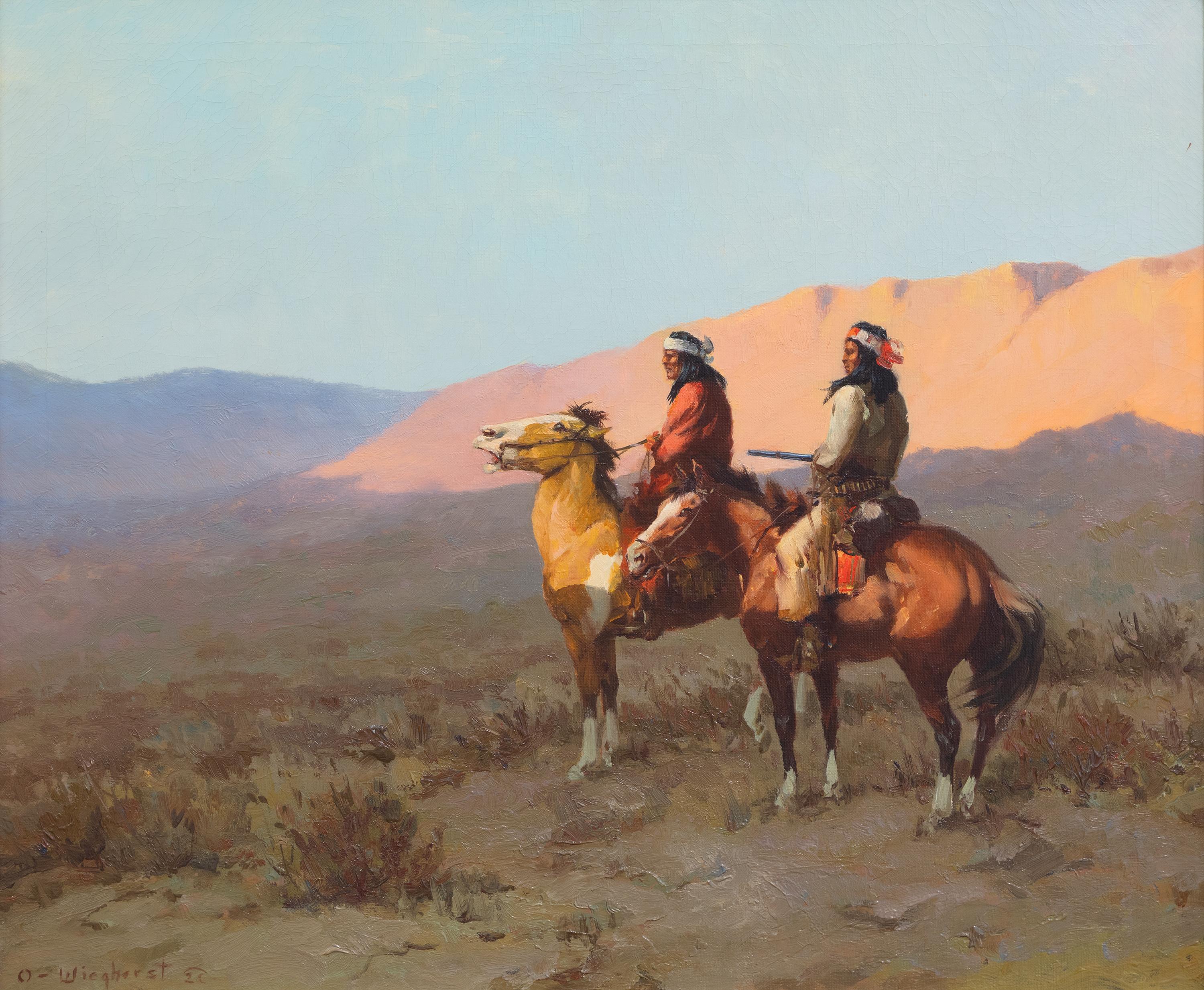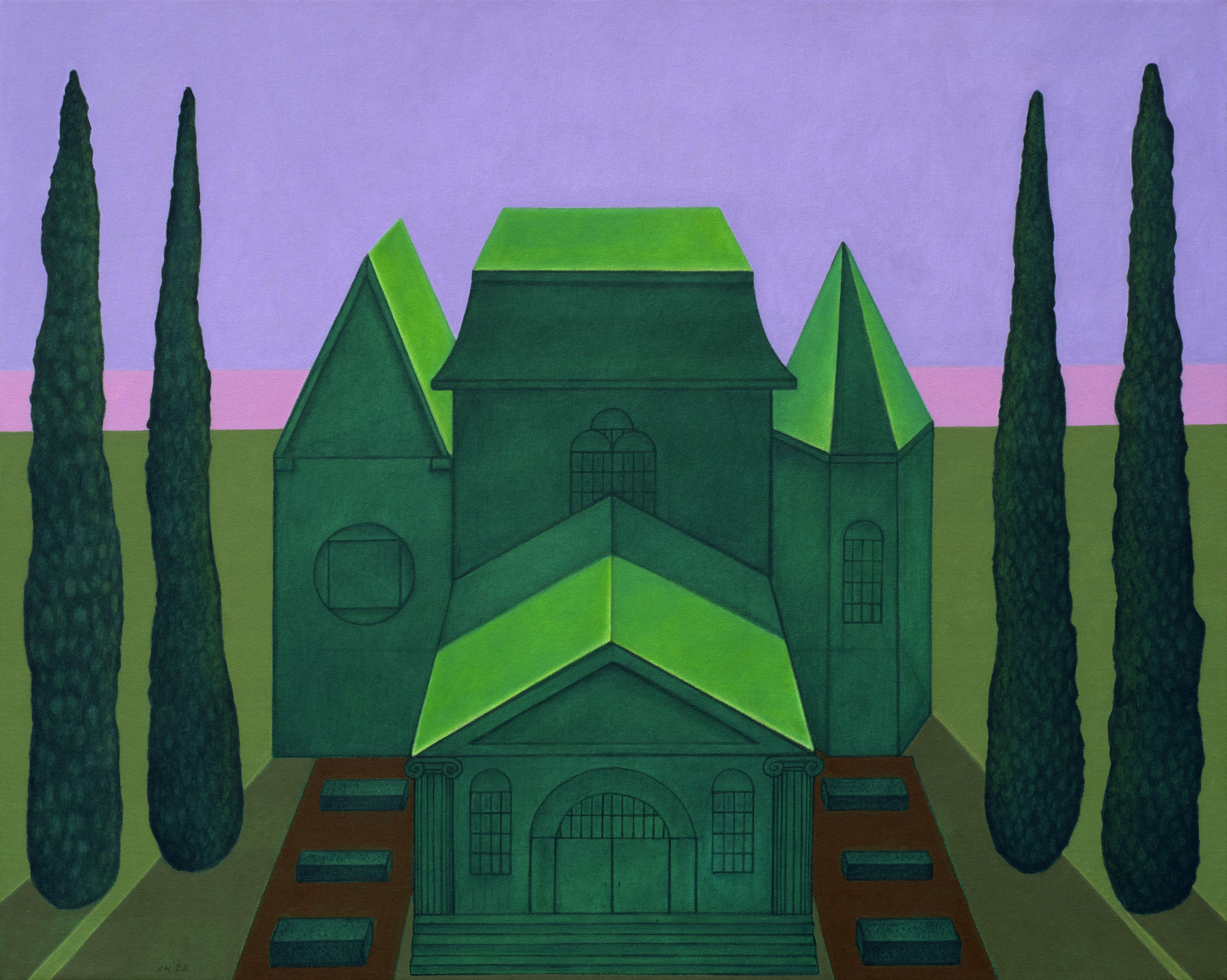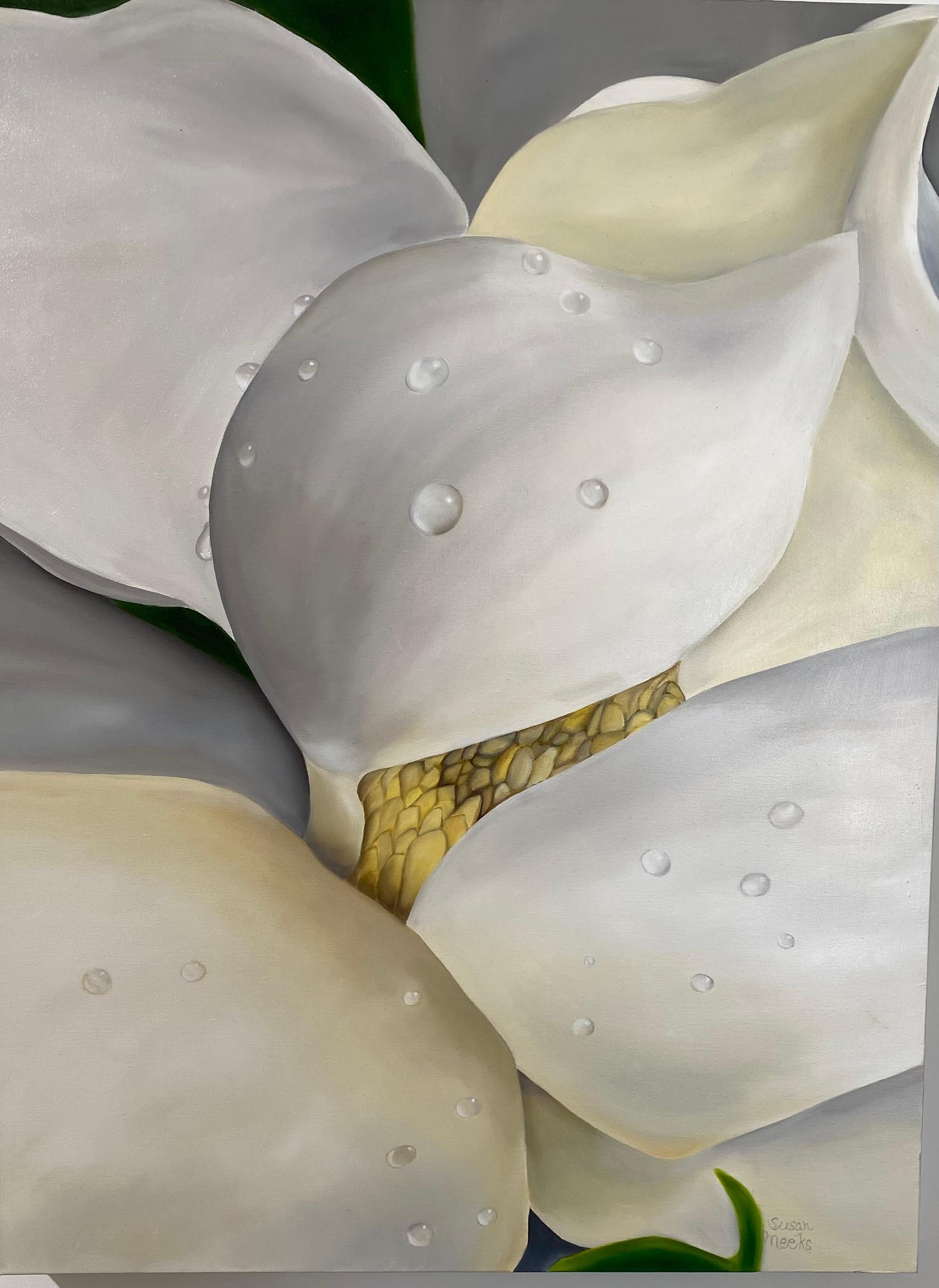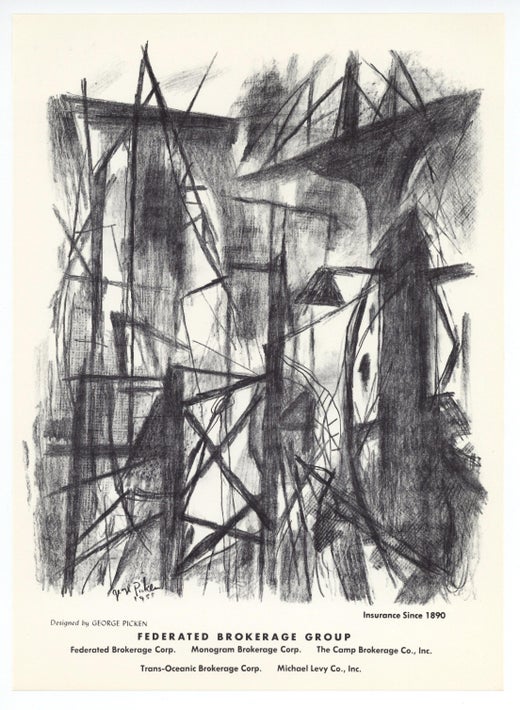Items Similar to "Blackwell's Island (Roosevelt Island, New York City), " George Picken, WPA Scene
Want more images or videos?
Request additional images or videos from the seller
1 of 8
George Picken"Blackwell's Island (Roosevelt Island, New York City), " George Picken, WPA Scene1928
1928
About the Item
George Picken (1898 - 1971)
The Octagon at Blackwell's Island (Roosevelt Island, New York City), 1928
Oil on canvas
22 x 27 inches
Signed lower right
Provenance:
D. Wigmore Fine Art, New York, circa 1999-2000
Private Collection, New York
A native New Yorker, George Picken was born in 1898. His father, an artist and photographer, emigrated from Scotland; his mother came from Wales. They joined other European immigrants settling in New York City’s Hell’s Kitchen. Picken enlisted in the army during World War I and saw action at Verdun. After the war, he stayed in France and like many Americans returning from the vibrant Paris art scene, was inspired by the radical movement known as Impressionism. Upon his return Picken decided to follow in his father’s footsteps and become an artist.
George began his studies in 1919 at the Art Students League during Robert Henri, Max Weber, and John Sloan’s tenure. There he took classes in studio art, illustration, and etching through 1923 studying extensively with George Bridgman. The writings of French philosopher Henri Bergson were widely circulated among the artistic community and looking at Picken’s early paintings one cannot help but wonder if as a young artist he was influenced by Bergson’s ideas. Bergson said, "[There are] two profoundly different ways of knowing a thing. The first implies that we move round the object; the second that we enter into it. The first depends on the point of view at which we are placed and on the symbols by which we express ourselves. The second neither depends on a point of view nor relies on any symbol. The first kind of knowledge may be said to stop at the relative; the second, in those cases where it is possible, to attain the absolute.”
Picken’s recognition came early with showings of his work while he was a student. His drawings were published in the New Masses, a significant left-wing publication. The New York Public Library honored him with one-man shows in 1924 and 1928 and his work was included in group exhibitions at the Louis Comfort Tiffany Foundation, the Whitney Studio Club, Montross Gallery, and the Art Students League. During this time Picken married Viola Carton, one of Reginald Marsh’s models, and they lived in Westchester. Later they moved to Yorkville in Manhattan between 82nd street and East End Avenue where they began their family. Picken’s grandson Niles Jaeger recalled that, “Grandpa’s home and studio were in a five-story walk-up apartment, heated only by a coal stove. But there were wonderful views of the East River and the Queensborough Bridge and he painted them repeatedly over the next three decades.”
Picken felt the financial panic and economic depression that engulfed most of the world in 1931; [he] was trying to support a wife and two children on his earnings as an artist….Franklin Delano Roosevelt promised “a new deal for the American people” at the 1932 Democratic Convention [and] the Federal Art Project was formed. During the run of the [WPA] over ten thousand artists were employed including Picken’s friends Stuart Davis and Reginald Marsh. Arshile Gorky, Isabel Bishop, Grant Wood, Ben Shahn, Adolph Gottlieb, David Smith, Willem deKooning, Jackson Pollock, Mark Rothko, Ad Reinhardt, and Paul Cadmus also found work. Along with Rockwell Kent, John Steuart Curry, and Thomas Hart Benton, Picken was commissioned to do public murals. Picken’s work can be found in the Post Offices of Hudson Falls and Fort Edward, New York and Chardon, Ohio. He also completed public murals for St. Ambrose Church in Brooklyn and Hawthorne Public School in Hawthorne, New York.
In 1933 George Picken was also offered a position as a teacher at the Art Students League. He taught printmaking there through 1942 as well as teaching painting, printmaking, and lithography at Cooper Union and holding a position at Columbia University. During this time Picken achieved notoriety for his paintings of industrial and city scenes like Mining Town. Stuart Davis remarked that his friend’s dark urban scenes were like “dungeons.” Marie Harriman, wife of railroad baron Averill Harriman, was Picken’s first patron giving him one-person shows at her gallery. In the 1940s with the guidance of Edward Hopper, Picken joined the prestigious Rehn Galleries on Madison Avenue. Rehn Galleries also exhibited the work of Reginald Marsh and Charles Burchfield. Picken’s had regular one-person shows there until his death.
George Picked retired to Tyringham and continued painting and gardening until his death at the age of seventy-three in 1971. Picken’s work is in many private and public collections including the Whitney Museum of American Art, The Corcoran Gallery of Art, The Metropolitan Museum of Art, Dartmouth College, the Kansas City Art Institute, the Smithsonian Institution, the Library of Congress, the Parrish Art Museum, Syracuse University, the Art Students League, and the Newark Museum.
- Creator:George Picken (1898 - 1971, American)
- Creation Year:1928
- Dimensions:Height: 28 in (71.12 cm)Width: 33 in (83.82 cm)
- Medium:
- Movement & Style:
- Period:
- Condition:Lined. Hairline craquelure.
- Gallery Location:New York, NY
- Reference Number:1stDibs: LU184129923522
George Picken
A native New Yorker, George Picken was born in 1898. His father, an artist and photographer, emigrated from Scotland; his mother came from Wales. They joined other European immigrants settling in New York City’s Hell’s Kitchen. Picken enlisted in the army during World War I and saw action at Verdun. After the war, he stayed in France and like many Americans returning from the vibrant Paris art scene, was inspired by the radical movement known as Impressionism. Upon his return Picken decided to follow in his father’s footsteps and become an artist. George began his studies in 1919 at the Art Students League during Robert Henri, Max Weber, and John Sloan’s tenure. There he took classes in studio art, illustration, and etching through 1923 studying extensively with George Bridgman. Picken’s recognition came early with showings of his work while he was a student. His drawings were published in the New Masses, a significant leftwing publication. The New York Public Library honored him with one-man shows in 1924 and 1928 and his work was included in group exhibitions at the Louis Comfort Tiffany Foundation, the Whitney Studio Club, Montross Gallery, and the Art Students League. Later he moved to Yorkville in Manhattan between 82nd street and East End Avenue where they began their family. Picken’s grandson Niles Jaeger recalled that, “Grandpa’s home and studio were in a five-story walk-up apartment, heated only by a coal stove. But there were wonderful views of the East River and the Queensborough Bridge and he painted them repeatedly over the next three decades.” Picken felt the financial panic and economic depression that engulfed most of the world in 1931. During the run of the [WPA] over ten thousand artists were employed including Picken’s friends Stuart Davis and Reginald Marsh. Arshile Gorky, Isabel Bishop, Grant Wood, Ben Shahn, Adolph Gottlieb, David Smith, Willem deKooning, Jackson Pollock, Mark Rothko, Ad Reinhardt, and Paul Cadmus also found work. Along with Rockwell Kent, John Steuart Curry, and Thomas Hart Benton, Picken was commissioned to do public murals. Picken’s work can be found in the Post Offices of Hudson Falls and Fort Edward, New York and Chardon, Ohio. In 1933 George Picken was also offered a position as a teacher at the Art Students League. He taught printmaking there through 1942 as well as teaching painting, printmaking, and lithography at Cooper Union and holding a position at Columbia University. During this time Picken achieved notoriety for his paintings of industrial and city scenes. Stuart Davis remarked that his friend’s dark urban scenes were like “dungeons.” Marie Harriman, wife of railroad baron Averill Harriman, was Picken’s first patron giving him one-person shows at her gallery. In the 1940s with the guidance of Edward Hopper, Picken joined the prestigious Rehn Galleries on Madison Avenue. Rehn Galleries also exhibited the work of Reginald Marsh and Charles Burchfield. Picken’s had regular one-person shows there until his death.
About the Seller
5.0
Platinum Seller
These expertly vetted sellers are 1stDibs' most experienced sellers and are rated highest by our customers.
Established in 2021
1stDibs seller since 2022
63 sales on 1stDibs
Typical response time: <1 hour
- ShippingRetrieving quote...Ships From: Larchmont, NY
- Return PolicyA return for this item may be initiated within 3 days of delivery.
More From This SellerView All
- "Tully Lumber Mill, Orange, Massachusetts, " Dorothy Eaton, WPA Factory RuralLocated in New York, NYDorothy Eaton Tully Lumber Mill, Orange, Massachusetts, 1935 Signed and dated lower right Oil on canvas 17 1/2 x 23 1/2 inches Dorothy Eaton was born in East Orange, New Jersey in 1893. She studied at Smith College...Category
1930s American Realist Landscape Paintings
MaterialsCanvas, Oil
- "Motion, " Victor Arnautoff, San Francisco Lighthouse, World's Fair WPA PaintingBy Victor Michail ArnautoffLocated in New York, NYVictor Mikhail Arnautoff (1896 - 1979) Motion (Mile Rocks Lighthouse), San Francisco, 1939 Oil and tempera on board 60 x 40 inches Signed lower left Provenance: The artist California School of Fine Arts (CFSA) John & Lynne Bolen Fine Arts, Huntington Beach, California Exhibited: New York, World's Fair, Exhibition of Contemporary American Art, 1939. San Francisco Museum of Art, 1962. Literature: American Art from the New York World's Fair 1939, Poughkeepsie, 1987, no. 11, p. 41, illustrated. Robert W. Cherny, Victor Arnautoff and the Politics of Art, Urbana, Illinois, 2017. The lighthouse in the distance is the Mile Rocks Lighthouse in San Francisco Bay, built in 1906 after many shipwrecks made the lighthouse necessary. In 1962 the lighthouse was reduced in size to make room for a helipad. Arnautoff was the son of a Russian Orthodox priest. He showed a talent for art from an early age and hoped to study art after graduating from the gymnasium in Mariupol. With the outbreak of World War I, he enrolled in the Yelizavetgrad Cavalry School. He went on to hold military leadership positions in the army of Nicholas II and the White Siberian army. With the defeat of the Whites in Siberia, he crossed into northeastern China and surrendered his weapons. Arnautoff remained in China for five years. He again tried to pursue art, but was impoverished and took a position training the cavalry of the warlord Zhang Zuolin. He met and married Lydia Blonsky and they had two sons, Michael and Vasily. In November 1925 Arnautoff went to San Francisco on a student visa to study at the California School of Fine Arts. There he studied sculpture with Edgar Walter and painting with several instructors. His wife and children joined him, and they all continued to Mexico in 1929, where, on Ralph Stackpole...Category
1930s American Realist Landscape Paintings
MaterialsTempera, Oil, Canvas
- "Shanties in the Bronx, New York" Bumpei Usui, Japanase-American City LandscapeLocated in New York, NYBumpei Usui Shanties in the Bronx, 1933 Signed lower right Oil on canvas 14 x 20 inches Provenance: The artist's estate Salander O'Reilly Galleries, New Y...Category
1930s American Realist Landscape Paintings
MaterialsCanvas, Oil
- "Backyard, Staten Island, New York" Bumpei Usui, Japanase-American LandscapeLocated in New York, NYBumpei Usui Backyard, Staten Island, 1933 Signed lower right Oil on canvas 20 x 24 inches Provenance: The artist's estate Salander O'Reilly Galleries, New...Category
1930s American Realist Landscape Paintings
MaterialsCanvas, Oil
- "Playground, Carl Schurz Park" George Picken, New York City, East River, UES WPABy George PickenLocated in New York, NYGeorge Picken Playground, Carl Schurz Park, 1938 Signed and dated lower left Oil on canvas 28 x 36 inches Provenance: Estate of the artist A native New Yorker, George Picken was born in 1898. His father, an artist and photographer, emigrated from Scotland; his mother came from Wales. They joined other European immigrants settling in New York City’s Hell’s Kitchen. Picken enlisted in the army during World War I and saw action at Verdun. After the war, he stayed in France and like many Americans returning from the vibrant Paris art scene, was inspired by the radical movement known as Impressionism. Upon his return Picken decided to follow in his father’s footsteps and become an artist. George began his studies in 1919 at the Art Students League during Robert Henri, Max Weber, and John Sloan’s tenure. There he took classes in studio art, illustration, and etching through 1923 studying extensively with George Bridgman. The writings of French philosopher Henri Bergson were widely circulated among the artistic community and looking at Picken’s early paintings one cannot help but wonder if as a young artist he was influenced by Bergson’s ideas. Bergson said, "[There are] two profoundly different ways of knowing a thing. The first implies that we move round the object; the second that we enter into it. The first depends on the point of view at which we are placed and on the symbols by which we express ourselves. The second neither depends on a point of view nor relies on any symbol. The first kind of knowledge may be said to stop at the relative; the second, in those cases where it is possible, to attain the absolute.” Picken’s recognition came early with showings of his work while he was a student. His drawings were published in the New Masses, a significant left-wing publication. The New York Public Library honored him with one-man shows in 1924 and 1928 and his work was included in group exhibitions at the Louis Comfort Tiffany Foundation, the Whitney Studio Club, Montross Gallery, and the Art Students League. During this time Picken married Viola Carton, one of Reginald Marsh’s models, and they lived in Westchester. Later they moved to Yorkville in Manhattan between 82nd street and East End Avenue where they began their family. Picken’s grandson Niles Jaeger recalled that, “Grandpa’s home and studio were in a five-story walk-up apartment, heated only by a coal stove. But there were wonderful views of the East River and the Queensborough Bridge...Category
1930s American Realist Landscape Paintings
MaterialsCanvas, Oil
- "Colonial Sand and Stone Company, New York, " Industrial WPA Scene, PrecisionistBy William SharpLocated in New York, NYWilliam Sharp (1900 - 1961) Factory on the River Oil on canvas 20 1/2 x 28 1/2 inches Initialed lower left: WS Provenance: Estate of the artist Private Collection, New York Swann Auction Galleries, American Art, June 13, 2019, Lot 178 Private Collection, New York Colonial Sand and Stone Co., founded by Generoso Pope, was once the country’s largest sand and gravel business, providing the concrete for much of New York City’s skyline, including the Empire State Building, Rockefeller Center, Radio City Music Hall, airports and subways. William Sharp was born on June 13, 1900, in Lemberg, Austria, where he attended college and the Academy for Arts and Industry. He later studied in Kraków, Poland, and in Berlin and Munich, Germany. Sharp began his career as a designer of stained-glass windows and as a painter of murals. He served in the German army during World War I. After the war he became a newspaper artist in Berlin and a well-known etcher. Sharp drew political cartoons that were bitterly critical of the growing Nazi movement. As the influence of National Socialism intensified, he began to contribute drawings, under a pseudonym, to publications that were hostile to Hitler. After Hitler assumed power, Sharp was confronted with these drawings and told that he would be sent to a concentration camp. However, in 1934, he escaped to the United States. His first newspaper assignment in America was making courtroom sketches for The New York Mirror...Category
Mid-20th Century American Realist Landscape Paintings
MaterialsCanvas, Paint, Oil
You May Also Like
- Pathway to the San Gabrielino Trail; Neglected and ProtectedBy Tim SollidayLocated in Pasadena, CAProvenance Acquired by the gallery directly from the artist Painted en plein air in the San Gabriel Mountains near the artist's home in the early summer of 2013. Description As part...Category
2010s American Realist Landscape Paintings
MaterialsCanvas, Oil
- Landscape with Mustard Flowers - 48 inch circular canvasBy Willard DixonLocated in Burlingame, CALandscape painting with mustard flowers under a warm sky. Created on a circular canvas that is 48 inches across (4 feet in diameter.) The original work of art ...Category
21st Century and Contemporary American Realist Landscape Paintings
MaterialsCanvas, Oil
- ScoutingBy Frank Tenney JohnsonLocated in Palm Desert, CA"Scouting" is an oil on canvas painting by Frank Tenney Johnson. The framed piece measures 23 3/4 x 27 3/4 x 3 1/4 inches. Johnson was well-known for his work of the American west, particularly for his portrayal of cowboys at night, lit by moonlight. Johnson utilized knives and fingers when painting, so his work is recognizable for its distinctive marks. Provenance: Biltmore Galleries, Scottsdale...Category
Early 20th Century American Realist Landscape Paintings
MaterialsCanvas, Oil
- ApachesBy Olaf WieghorstLocated in Palm Desert, CA"Apaches" is an oil on canvas painting by Olaf Wieghorst. The painting is signed on the lower left, "O-Wieghorst". The framed piece measures 25 1/2 x 29 3/4 x 2 in. “When the time comes for me to put away my palette and unsaddle my pony for the last time, I hope that my canvases will in some small measure add to the historical recording of an era, the cowboy, and the great American West.” ~ Olaf Wieghorst Wieghorst worked with the mounted patrol of the 7th Cavalry Regiment of the United States Cavalry (1920-1922) with occasional interludes as a wrangler on ranches in the western states. Wherever he went, he sketched and painted the Western culture he loved, often selling his work as calendar and magazine illustrations. His work appeared in Zane Grey...Category
Early 20th Century American Realist Landscape Paintings
MaterialsCanvas, Oil
- The Green House, Surreal Classic Architecture with Italian Cypress TreesBy John HrehovLocated in Chicago, ILA classical structure is cast in a green hue as the sun sets on this surreal scene by John Hrehov. The perfectly balance scene, with its formal gardens and Italian cypress trees add to the overall aesthetic. This piece is floated in a white wooden frame measuring 26h x 32w x 2d inches. John Hrehov The Green House oil on canvas 24h x 30w in 60.96h x 76.20w cm JHR024 John Hrehov Education 1985 MFA-Painting, University of Illinois at Urbana-Champaign 1981 BFA-Painting, Cleveland Institute of Art, Cleveland, OH. Solo Exhibitions 2017 John Hrehov, Paintings and Drawings. Tom Thomas Gallery, Indiana University East, Richmond, IN. 2012 Shades from White to Black, New Drawings. Denise Bibro Fine Art, New York, NY. 2011 John Hrehov: Charcoal. Indiana University - Purdue University Fort Wayne...Category
2010s American Realist Landscape Paintings
MaterialsCanvas, Oil
- Close Up Magnolia in the Rain Realism 40 x 30 Oil Canvas Floral PaintingLocated in Houston, TXClose up of Magnolia after the Rain is 40 x 30.. Gallery Wrapped Susan is a native Houstonian. She is passionate about oil painting, specializing in large scale florals. She was inspired to start painting florals when she began photographing flowers on her daily walks. Susan is an early childhood educator and teaches at a private school in Houston. She is a member of the Lassaulx studio in Houston, Texas. Susan graduated from HCC with honors with a degree in Fine Arts. She studied at the Glassell School of the Museum of Fine Arts, Houston. Susan Meeks...Category
2010s American Realist Still-life Paintings
MaterialsOil, Canvas
Recently Viewed
View AllMore Ways To Browse
French Island
European Island
Antique Islands
Wood Island
George Marks
1940s Island
Etching New York City
New York Apartment
Round Island
Antique Wood Island
Native American Warror
Native American War Art
Used Island For Kitchen
French Industrial Island
Louis Comfort Tiffany Art Work
Island Etching
Kitchen Work Island
Louis Comfort Tiffany Paintings
